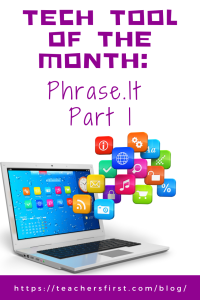Phrase.It is an easy-to-use website that allows you to add cartoon speech bubbles to any photo in seconds without requiring registration or membership. You can upload an image from your device or use one from the site’s stock photo collection, then select one of five different types of speech bubbles to drag and drop anywhere on the image and add text in various fonts. When you’re finished, you can mark your photo private, download the image and save it on your device, or share the image using a URL by providing your email address. Phrase.It will work on any device with a web browser and could be used as part of a blended, flipped, or remote learning activity. Finally, don’t miss the Phrase.It blog which offers many helpful articles about how to use the tool and ways to implement it in the classroom.
Applying the Triple E Framework
The Triple E Framework, created by Dr. Liz Kolb, states that “effective technology integration begins with good instructional strategies and not fancy tools” (tripleeframework.com). Dr. Kolb wrote a book on the topic, Learning First, Technology Second (ISTE, 2017), that lays out the three main uses for technology in education: to engage, enhance, or extend learning goals. We can use this framework to decipher why we use specific classroom tools. Here is a rubric based on the Triple E Framework that you can use to evaluate whether Phrase.It (or any other technology) is a good fit with your learning goals and whether you should use it in your lesson.
- Engage in learning goals: Phrase.It motivates students to begin learning by allowing them to create their own speech bubbles to share information. Students also become active rather than passive learners as they create their own projects instead of merely looking at images created by others.
- Enhance learning goals: Phrase.It aids students in demonstrating a more sophisticated understanding of content by creating short writings with images.
- Extend learning goals: Dr. Kolb describes extended learning as an opportunity for students to learn, connect, and collaborate outside the regular school day and bridge the school day and real-life experiences. Phrase.It can be used as a remote, flipped, or blended learning activity and would also make an ideal asynchronous learning experience for students ages 13 and over.
SAMR Connection
The SAMR Model by Dr. Ruben Puentedura suggests that technology implementation has four levels. Therefore, we can use this model as a guideline to analyze how we use technology tools in the classroom. For example, we can use Phrase.It at the substitution, augmentation, and modification levels, depending on what students are doing.
- Substitution: The substitution level is the most basic level of SAMR and refers to when technology acts as a direct substitute without any functional improvements. An easy example is students using Phrase.It rather than pen and paper to create images and speech bubbles.
- Augmentation: At the level of augmentation, the technology acts as a direct substitute and includes some functional improvements. We could take Phrase.It to the level of augmentation by having students upload their own images to this site, choose the speech bubble type, and change fonts. Without technology, these changes would be much more difficult (if not impossible) without starting over.
- Modification: The level of modification allows us to make (or modify) the activity into something more integrated with technology, meaning there is significant task redesign. We could move Phrase.It to the level of modification by having students share the link to their Phrase.It images with their teacher or other classmates.
Take advantage of Part 2 of the Tech Tool of the Month: Phrase.It and learn how to use the tool and integrate it in your classroom. In the meantime, let us know how you’ve used Phrase.It in your education setting in the comment section below.


